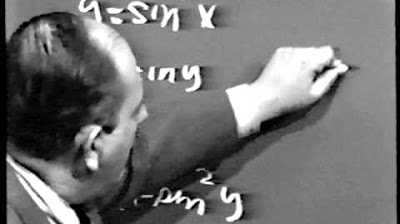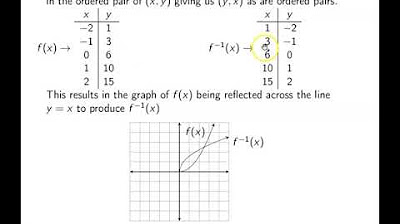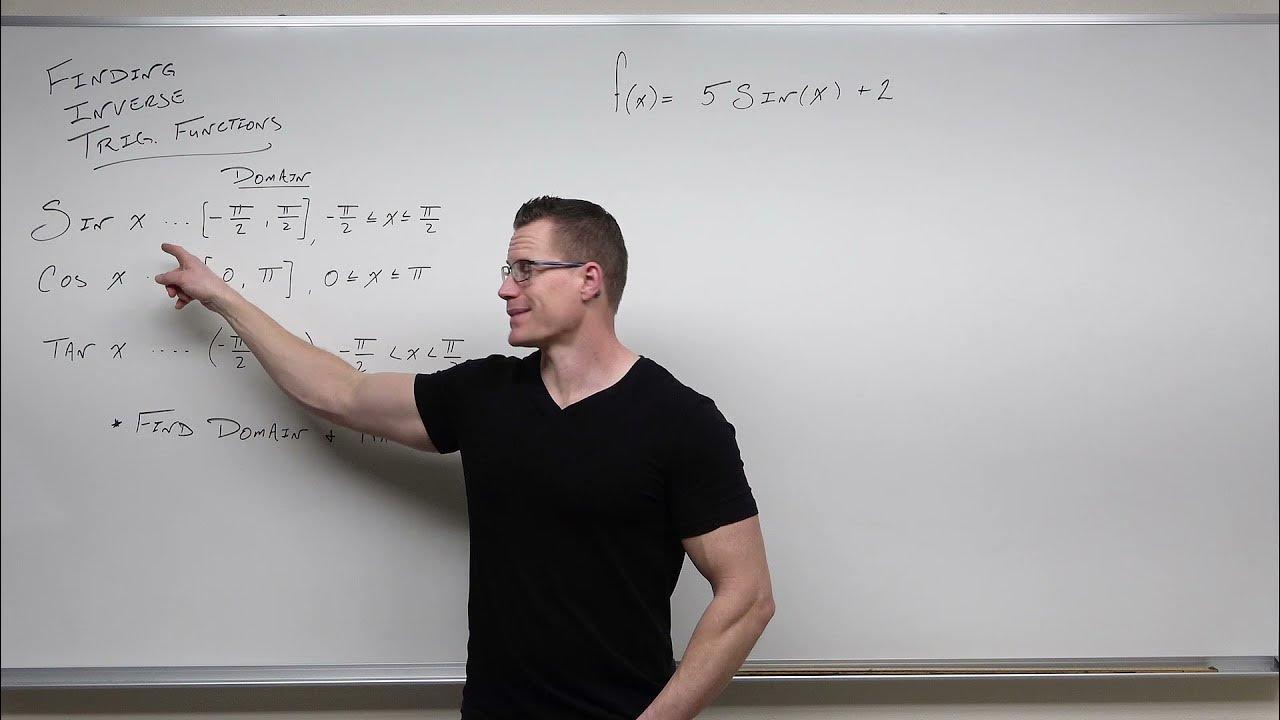Unit I: Lec 3 | MIT Calculus Revisited: Single Variable Calculus
TLDRThis MIT OpenCourseWare lecture explores the concept of inverse functions, essential in calculus and pre-calculus. It explains how inverse functions, like subtraction to addition or logarithms to exponents, switch the roles of variables. The lecturer uses examples, including linear functions and trigonometric identities, to illustrate how to find and understand inverse functions. The importance of a function being both one-to-one and onto for an inverse to exist is highlighted, along with the graphical representation of inverse relationships and the challenges of non-invertible functions.
Takeaways
- 📚 The lecture introduces the concept of inverse functions and their importance in mathematics and calculus.
- 🔄 Inverse functions represent a switch in emphasis from the original function, allowing for a different variable to be emphasized.
- 🤔 The idea of inverse functions is intuitively explained through elementary math concepts like addition and subtraction, and how they are inverse operations.
- 📈 The script uses the analogy of a 'function machine' to explain how functions and their inverses operate and how they are related.
- 📉 The video discusses the conditions for a function to have an inverse, specifically that it must be both one-to-one (1:1) and onto.
- 📝 It explains that the domain of the original function must equal the range of its inverse, and vice versa, for the inverse function to exist.
- 📊 The script illustrates the graphical representation of inverse functions and how they are mirror images with respect to the line y=x.
- 📐 It points out that for non-invertible functions, such as those with breaks or that double back, the concept of inverse functions does not apply.
- 🔢 The lecture provides a step-by-step example using the function y = 2x - 7 to demonstrate how to find and understand its inverse function.
- 📉 The concept of principal values is introduced to handle functions that are not single-valued, such as the square root function, by breaking them into pieces that are 1:1 and onto.
- 🔍 The script emphasizes the importance of understanding and correctly applying the concept of inverse functions to avoid misinterpretation in mathematical problems.
Q & A
What is the main topic of the lecture?
-The main topic of the lecture is inverse functions, their applications, and their significance in mathematics and calculus.
Why are inverse functions valuable in mathematics?
-Inverse functions are valuable because they have a wide range of applications in calculus and are important in their own right, even as a pre-calculus topic.
What is the relationship between addition and subtraction in terms of inverse operations?
-Addition and subtraction are inverse operations because subtraction can be thought of as finding the number that must be added to one number to get another, thus reversing the process of addition.
How does the concept of inverse functions relate to the change-making technique in stores?
-In the change-making technique, the clerk often adds the necessary amount to the purchase total to match the denomination of the bill paid, which is an example of using the inverse operation of subtraction in a practical context.
What is the connection between exponents and logarithms in the context of inverse functions?
-Exponents and logarithms are inverse functions because if y equals the log of x to the base b, it is synonymous with saying b to the power of y equals x, thus emphasizing different variables.
What is the graphical relationship between a function and its inverse?
-Graphically, a function and its inverse are related in that they are mirror images of each other with respect to the line y equals x.
Why is it necessary for a function to be both 1:1 and onto to have an inverse function?
-A function must be both 1:1 and onto to have an inverse because this ensures that each element in the range corresponds to exactly one element in the domain, and vice versa, allowing for a unique inverse operation.
What is the significance of the identity function in the context of inverse functions?
-The identity function is significant because it represents the composition of a function and its inverse, which results in the original input when applied, demonstrating the reversibility of the inverse function.
How does the concept of inverse functions relate to the idea of independent and dependent variables in calculus?
-In the context of calculus, the independent variable is usually plotted on the x-axis, and the dependent variable on the y-axis. Inverse functions switch these roles, emphasizing the variable that was previously dependent.
What is the practical implication of understanding inverse functions in the field of trigonometry?
-In trigonometry, understanding inverse functions allows one to work with inverse trigonometric functions, such as arcsine, arccosine, and arctangent, which are essential for solving various mathematical problems involving trigonometric relationships.
Why is it important to consider the domain and range when discussing the existence of an inverse function?
-Considering the domain and range is important because the existence of an inverse function depends on the original function being defined for all elements in its domain and producing a unique output for each input, ensuring a well-defined inverse.
Outlines
📚 Introduction to Inverse Functions
Herbert Gross introduces the concept of inverse functions, emphasizing their fundamental role in pre-calculus and their application in calculus. He explains the idea of inverse functions by drawing parallels with basic arithmetic operations like addition and subtraction, illustrating how knowing one operation allows you to understand its inverse. The lecture also touches on the importance of functions being both 1:1 (one-to-one) and onto for an inverse to exist, and how inverse functions can be thought of as paraphrasing the original function with an emphasis switch between the dependent and independent variables.
🔍 Exploring Inverse Functions in Detail
This paragraph delves deeper into the mechanics of inverse functions, using the example of a simple linear function y = 2x - 7 and its inverse x = (y + 7) / 2. The explanation covers how to find the inverse function by solving for the variable in terms of the other, and how the inverse function effectively reverses the roles of input and output. The discussion also includes the geometric interpretation of inverse functions, considering the function machine analogy and the identity function resulting from composing a function with its inverse.
📉 Conditions for a Function to Have an Inverse
The script explains the necessary conditions for a function to possess an inverse: the function must be both 1:1 and onto. It uses a diagram to illustrate the concept, showing how reversing the roles of input and output is only possible if the original function maps uniquely and completely onto its range. The paragraph also discusses the implications of a function not being onto or not being 1:1, and how these conditions prevent the existence of a well-defined inverse function.
📈 Graphing and Understanding Inverse Functions
This section discusses how to determine if a function has an inverse by examining its graph. It explains that a function is onto if its graph is unbroken and is 1:1 if it neither breaks nor doubles back. The paragraph also addresses the difference between continuous and discrete data, and how multi-valued functions can be broken down into single-valued functions to avoid confusion when considering inverse functions.
🤔 The Abstract Concept of Inverse Functions
The script presents an abstract view of inverse functions, using the example of a continuous and rising curve to discuss the inverse function. It explains how the same curve can be represented by two different equations, one in terms of y = f(x) and the other as x = f^(-1)(y), and how these equations are related by a 90-degree rotation and flip of the graph. The paragraph also touches on the challenges of interpreting inverse functions when the traditional orientation of the axes is not used.
🔄 The Relationship Between a Function and Its Inverse
This paragraph explores the geometric relationship between a function and its inverse when graphed on the same coordinate system. It uses the example of the line y = 2x - 7 and its inverse x = (y + 7) / 2, explaining how these lines are related as mirror images with respect to the line y = x. The explanation includes a step-by-step geometric transformation to illustrate how the inverse function's graph is derived from the original function's graph.
🚫 Handling Non-invertible Functions
The script addresses the issue of non-invertible functions, such as y = sqrt(x), and the convention of taking the positive square root. It explains how multi-valued functions can be decomposed into single-valued pieces to facilitate the discussion of inverse functions. The paragraph also introduces the concept of principal values and the importance of clear restrictions to avoid misinterpretation when dealing with inverse functions.
🔚 Concluding Remarks on Inverse Functions
In the concluding paragraph, the lecturer summarizes the importance of inverse functions, emphasizing that they provide an alternative way to express the same information as the original function. The paragraph highlights the need for careful consideration when dealing with non-1:1 functions and the importance of matching the correct pieces when discussing inverse functions. It also foreshadows the further exploration of inverse functions in the context of calculus in later lectures.
📖 Funding and Closing Acknowledgements
The final part of the script is an announcement about the funding for the video's publication, provided by the Gabriella and Paul Rosenbaum Foundation. It encourages viewers to support MIT OpenCourseWare to continue offering free educational resources by donating at the provided link. The announcer also thanks the viewers for their attention and bids them farewell until the next session.
Mindmap
Keywords
💡Inverse Functions
💡1:1 and Onto Functions
💡Independent and Dependent Variables
💡Exponents and Logarithms
💡Trigonometric Functions
💡Function Composition
💡Identity Function
💡Continuous and Discrete Variables
💡Vertical and Horizontal Tangents
💡Principal Values
Highlights
Inverse functions are crucial in calculus and have applications in various mathematical fields.
The concept of inverse functions is introduced as early as first grade, with subtraction being the inverse of addition.
Multiplication and division are presented as inverse operations, emphasizing the switch in emphasis between the operations.
Exponents and logarithms are highlighted as inverse functions, with y = log base b of x being the inverse of b^y = x.
The importance of the independent and dependent variable switch in inverse functions is discussed.
An example of finding an inverse function by solving for x in terms of y is given, illustrating the process.
The relationship between a function and its inverse is shown through the function machine analogy.
The identity function is introduced as the result of composing a function with its inverse.
The conditions for a function to have an inverse are explained: the function must be both 1:1 (one-to-one) and onto.
The graphical representation of inverse functions is discussed, including the mirror image relationship with respect to the line y=x.
The concept of principal values is introduced to handle non-invertible functions, such as y = sqrt(x), by considering only the positive root.
The process of breaking down multi-valued functions into single-valued pieces to find inverse functions is explained.
The danger of misinterpretation when dealing with non-1:1 functions and the importance of correctly identifying the relevant piece of the function for inverse functions are highlighted.
The practical application of inverse functions in change-making and other real-world scenarios is briefly mentioned.
The transcript concludes by emphasizing the importance of inverse functions in expressing the same information in different ways for problem-solving.
Transcripts
Browse More Related Video

Finding Inverse Functions (Precalculus - College Algebra 51)

Derivatives of Inverse Functions

Unit III: Lec 2 | MIT Calculus Revisited: Single Variable Calculus

Ch. 2.8 One-to-One Functions and their Inverses

How to Find Inverse Trigonometric Functions (Precalculus - Trigonometry 19)

Horizontal Line Test and One to One Functions
5.0 / 5 (0 votes)
Thanks for rating: